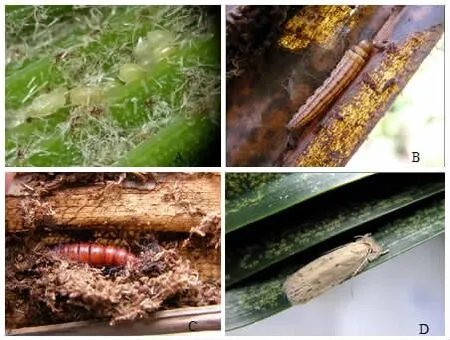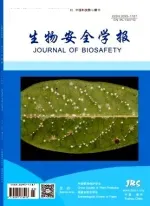警惕椰子织蛾Opisina arenosella Walker(鳞翅目:织蛾科)传入中国
吕宝乾,严 珍,金启安,温海波,符悦冠,李伟东,彭正强*中国热带农业科学院环境与植物保护研究所,农业部热带农林有害生物入侵监测与控制重点开放实验室/农业部儋州农业环境科学观测实验站,海南儋州5777;海南大学环境与植物保护学院,海南海口5708;海南出入境检验检疫局,海南海口570
随着对外开放和国际贸易的不断发展,我国外来生物入侵形势十分严峻。在世界自然保护联盟(IUCN)公布的全球100种最具威胁的外来物种中,我国就有50种,是全球受外来生物入侵影响最大的国家之一(万方浩等,2005)。入侵物种主要分布在我国东南部省份,如广东、海南、云南、福建(万方浩等,2009)。1998~2008年,海南和广东首次发现的入侵有害生物最多,各5种(万方浩等,2009)。例如,2002年入侵我国海南省的椰心叶甲Brontispa longissima(Gestro),给我国棕榈植物相关产业造成了巨大损失(吕宝乾等,2005)。因此,有必要关注有可能入侵我国的其他有害生物。
椰子织蛾Opisina arenosellaWalker是棕榈植物上的重要害虫。在印度、斯里兰卡和缅甸,椰子织蛾严重危害椰子树(Jayaratnam,1941;Rao,1924)。据了解,近几年该害虫已扩散蔓延到东盟国家的泰国和马来西亚,尤其在泰国,该虫危害严重,引起了相关部门的高度重视。为了提高对椰子织蛾的认识,防范该有害生物入侵我国,本文对该虫进行介绍,并进行风险分析。
1 椰子织蛾概况
1.1 分类地位及形态特征
Walker在1864年从不知名的寄主上发现了O.arenosella(Becher,1981)。椰子织蛾英文名为coconut blackheaded caterpillar,直译为椰子黑头履带虫。我国曾将其译为食叶履带虫、黑头履带虫(陈慧,2004)、椰蛀蛾(黄德聪,1987)。该害虫属鳞翅目Lepidoptera织蛾科Oecophoridae,也曾被归为木蛾科 Xylorycitdae(Becher,1981;Pereraet al.,1988)。
卵(图1A):半透明乳黄色,长椭圆形,具有纵横网格,成堆产于叶片上。
幼虫(图1B):5~8个龄期。雌、雄幼虫大小相似,雄性6~8龄幼虫虫体第9节前缘腹中腺表面有一圆形凹陷,雌虫无此凹陷,这一特征可用于辨别幼虫的性别。
蛹(图1C):红褐色,雌、雄虫蛹质量分别为(22.18±0.99)、(17.73 ±0.09)mg(Santhosh & Prabhu,1987)。
成虫(图1D):触角长5~7 mm,38~42节。中间各节呈圆柱形,最后一节呈锥形(Jayaprakash&Prabhu,1986)。

图1 椰子织蛾(由泰国农业部生物防治中心提供)Fig.1 O.arenosella(provided by Biological Center,Department of Agriculture,Thailand)
1.2 分布
椰子织蛾分布于印度、斯里兰卡、孟加拉国、缅甸(Venkatesanet al.,2009)、印尼、与印度古吉拉特邦毗邻的巴基斯坦、泰国和马来西亚等地。
1.3 寄主
椰子树Cocos nuciferaL.,扇叶树头榈Borrassus flabelliferL.(Raoet al.,1948),枣椰树Phoenix dactyliferaL.(Butani,1975),贝叶棕Corypha umbraculiferaL.(Talati& Kapadia,1984),野生枣椰树P.theophrastiGreuter,银海枣P.sylvestrisRoxb,西谷椰子Metroxylon saguRottboell,董棕Caryota urensL.(Raoet al.,1948),非洲棕Hyphaene thebaicaL.(Lever,1969),甘蓝椰子Oredoxa oleraceaKurth,蒲葵Livistona chinensisRob(Talati& Kapadia,1984),香蕉Musaspp.(Manjunath,1985;Talati & Butani,1988)。
从产卵和取食习性来看,椰子织蛾最喜欢扇叶树头榈,椰子次之,最不喜欢香蕉(Srinivasaet al.,1995)。
1.4 危害特征
椰子树整个生长阶段均易受到椰子织蛾的为害。椰子织蛾以幼虫为害叶片,留下排泄物,导致叶片光合作用效率下降。受害严重的植株叶子干枯,出现落叶。与椰子树上的另一种重要害虫椰心叶甲不同,椰子织蛾幼虫危害椰树老叶和新叶,而椰心叶甲只危害椰树新叶(图2)。椰子织蛾幼虫不仅食叶,而且取食苞芽,造成椰树花穗减少、生长迟缓、过早落果的现象,进而严重影响椰子产量(Lever,1969;Manjunath,1985)。幼虫和蛹能够通过椰子传播。椰子织蛾严重侵染椰子后,可造成45%椰子减产,13%叶片受损(Chandrikaet al.,2010)。

图2 椰子织蛾(A,由泰国农业部生物防治中心提供)和椰心叶甲(B)危害后的椰树Fig.2 Coconut harmed by O.arenosella(A,provided by Biological Center,Department of Agriculture,Thailand)and B.longissima(B)
1.5 生物学特性
据报道,雌蛾在叶片背面产卵。卵一般产在老叶上,卵量达59~252粒,平均137粒。在印度,椰子织蛾卵期大约5 d,幼虫期42 d,蛹期12 d,成虫寿命5~7 d,全世代需2~2.5个月,1年发生5代(Nirula,1955)。
2 椰子织蛾入侵风险分析
2.1 传播扩散的可能性
椰子织蛾成虫可以飞行,大多在晚间活动,这为其传播扩散提供了可能。此外,贸易往来是外来生物入侵的一个渠道。2008年中国检验检疫部门截获外来生物最多的10个国家中,东盟国家有4个,分别为泰国(13868批次)、马来西亚(13492批次)、越南(4623批次)和缅甸(4041批次)(万方浩等,2009)。我国与东盟国家贸易频繁,每年需从东盟国家进口20多亿个椰子,给椰子织蛾的远距离传播(主要靠苗木运输)打开了方便之门。
2.2 受害作物的经济重要性
根据海南省林业局统计,海南椰子每年直接产值约5亿元,槟榔每年直接产值约10亿元。棕榈植物是热带亚热带特有的树种,若该害虫入侵我国,将可能带来与椰心叶甲一样严重的生态灾害。
2.3 潜在的危害性
椰子织蛾幼虫取食叶片,并构筑丝网状虫道,严重时整个树冠被侵染,树叶干枯,树势衰弱,产量减少。该害虫也危害香蕉,在香蕉上的习性和造成的危害与在椰子嫩叶上相似。虽然该害虫在香蕉上偶尔发现,但可能演变成香蕉的重要害虫。香蕉作为椰子害虫的转寄主曾有先例,如椰子二疣犀甲Oryctes rhinocerosL.(黄德聪,1987)。我国公布的检疫性有害生物名录虽未将椰子织蛾列入其中,但也应警惕该害虫入侵我国。
3 椰子织蛾综合防治措施
3.1 加强检疫
1998~2008年,具有危险性与暴发性的农林入侵种多达19种,其中9种为我国进境检疫对象(万方浩等,2009)。为防止椰子织蛾传播蔓延,必须实施严格的植物检疫措施,并建议相关部门将该害虫列入我国进境检疫对象;对疫区进入的可携带椰子织蛾的材料尤其是棕榈科植物进行必要的处理;检验过程中主要查看叶片上是否有危害状,如果有,应进一步从叶片上采集幼虫或蛹进行准确的鉴定。
3.2 生物防治
椰子织蛾受一些土著寄生性和捕食性天敌(表1)控制。

表1 椰子织蛾的天敌Table 1 Recorded natural enemies of O.arenosella
Sujatha&Singh(2004)于1996~1997年在印度的卡纳塔克邦对椰子织蛾的寄生蜂监测发现,瓜野螟绒茧蜂Apanteles taragamaeViereck在沿海夏季和内陆雨季活跃,棉卷叶螟鳞茧蜂Meteoridea hutsoniNixon和大腿小蜂属Brachymeriaspp.分别在冬季和夏季占主导地位。Goniozus nephantidis(Muesebeck)在印度不同地区对椰子织蛾的寄生率不同:如在喀拉拉邦奎隆地区的寄生率为3.7% ~47.6%(Sathiammaet al.,1996);在马哈拉施特拉邦塔那地区为 57.6%(Desaiet al.,2003);在古吉拉特邦默胡瓦地区为31.0%;在安得拉邦贡土尔地区为 28.0%(Manjunath,1985);在班加罗尔地区为48.0%(Nadarajan & Channa,1980)。在斯里兰卡的寄生率为19.0%(Dharmaraju,1963)。Venkatesanet al.(2003)发现,G.nephantidis扩散依靠爬行而不是飞行。在田间离地面1.2 m的椰子树干释放G.nephantidis,90% ~100%的寄生蜂可达到树冠。每棵树释放10头G.nephantidis,连续释放4次效果最佳。在2种寄生蜂G.nephantidis和Bracon brevicomisWesm.竞争互作过程中,G.nephantidis能占有寄主保证后代繁衍,但却影响B.brevicomis对椰子织蛾的寄生控害效能(Venkatesanet al.,2009)。Jalaliet al.(2002)从11种赤眼蜂中筛选出椰子织蛾卵期寄生蜂食胚赤眼蜂Trichogramma embryophagumHartig,大田释放寄生率达82.1%。在印度每棵树释放50~100头花蝽Cardiustethus exiguousPoppius,能够显著降低野外椰子织蛾的种群数量(Lylaet al.,2006)。
3.3 化学防治
在印度西海岸,0.1%或0.2%DDT对棕榈树椰子织蛾具有很好的防治效果(Nirulaet al.,1951)。Sathiamma&Kurian(1972)报道,几种农药对椰子织蛾的防效依次为敌敌畏>敌百虫>残杀威>亚砜吸磷 >西维因。椰子织蛾暴发时,用0.02% 敌敌畏、0.05% 马拉硫磷、0.05% 硫丹和久效磷,有时用3%印楝种核提取物,喷施于叶片背面能够马上缓解疫情(Anjariaet al.,1975;Ponnamma,1984)。Kanagaratnam&Pinto(1985)和Nadarajan&Channa(1981)研究表明,通过树干注射杀虫剂对椰子织蛾有一定的防治效果。如通过树干注射印楝素水剂,24 h药剂可从树基部传导到树冠,对幼虫的控制效果显著(Shivashankaret al.,2000)。
3.4 农业防治
农业防治是预防椰子织蛾暴发的辅助措施。通过削减和烧毁这些被害叶片或枯叶等(Rohitha,1982),可以减少虫源。
致谢:感谢泰国农业部生物防治中心Amporn Winotai博士和泰国农业大学Namphueng Chomphukhiao博士提供相关信息。
陈慧.2004.椰子黑头履带虫的生物防治.世界热带农业信息,(7):21.
黄德聪.1987.香蕉和椰子上的椰蛀蛾.福建热作科技,(3):40.
吕宝乾,陈义群,包炎.2005.引进天敌椰甲截脉姬小蜂防治椰心叶甲的可行性探讨.昆虫知识,42(3):254-258.
万方浩,郭建英,李保平.2009.中国生物入侵研究.北京:科学出版社.
万方浩,郑小波,郭建英.2005.重要农林外来入侵物种的生物学与控制.北京:科学出版社.
Anjaria P I,Kikani K P,Shah A H and Vora V J.1975.Studies on the effect of some commonly used insecticides against coconut black-headed caterpillar(Nephantis serinopaMeyr.).Coconut Bulletin,6(5):1-2.
Becher V O.1981.Identities and provenance of the gelechioid moths originally described by Francis Walker from‘unknown countries’.Systematic Entomology,6:137-141.
Butani D K.1975.Insect pests of fruit crops and their control.Pesticides,9(2):40-42.
Chandrika M,Radhakrishnan N C P,Kesavan N C and Rajan P.2010.Leaf-eating caterpillar(Opisina arenosella)-induced yield loss in coconut palm.International Journal of Tropical Insect Science,30:132-137.
Desai V S,Narangalkar A L and Nagwekar D D.2003.Biological control of coconut black headed caterpillarOpisina arenosellaWalker.Indian Coconut Journal,34:6-8.
Dharmaraju E.1963.Biological control of coconut leaf caterpillar(Nephantis serinopaMeyrick)in Ceylon.Coconut Research Institute Bulletin(Ceylon),21:46.
Jalali S K,Singh S P and Venkatesan T.2002.Selection of promising species of trichogrammatid egg parasitoid for field evaluation against coconut leaf eating caterpillar,Opisina arenosellaWalker.Journal of Plantation Crops,30(2):30-32.
Jayaprakash R and Prabhu V K K.1986.Antennal sensilla ofOpisina arenosellaWalker[Lepidoptera:Cryptophasidae].Current Science,55:681.
Jayaratnam T J.1941.A study of the control of the coconut caterpillarNephantis serinopaMeyr.in Ceylon with special reference to its eulophid parasiteTrichospilus pupivoraFerr.Tropical Agriculturist(Ceylon),96:3-21.
Kanagaratnam P and Pinto J L J G.1985.Effect of monocrotophos on the leaf eating caterpillar,Opisina arenosellaWalk,when injected into the trunk of the coconut palm.Cocos,3:9-15.
Lever R J A W.1969.Pests of the coconut palm.FAO Agricultural Studies,77:190.
Lyla K R,Pathummal B S and Chandish B R.2006.Field evaluation of anthocorid predator,Cardiastethus exiguusPoppius againstOpisina arenosellaWalker(Lepidoptera:Oecophoridae)in Kerala.Journal of Biological Control,20:229-231.
Manjunath T M.1985.Coconut black headed caterpillar on banana and coconut.FAO Plant Protection Bulletin,33:58-72.
Muhammad B P P and Thomas S K.2012.Indian treepieDendrocitta vagabunda parvula(Latham,1790)(Passeriformes:Corvidae)as a natural enemy of the pests of coconut and areca palm plantations.Journal of Biopesticides,5:205-208.
Nadarajan L and Channa B G P.1980.Population dynamics of coconut black headed caterpillar,Nephantis serinopaMeyrick(Lepidoptera:Cryptophasidae)and its parasites.Mysore Journal of Agricultural Sciences,14:533-541.
Nadarajan L and Channa B G P.1981.Trunk injection of systemic insecticides against the coconut black headed caterpillarNephantis serinopaMeyrick(Lepidoptera:Cryptophasidae).Oleagineux,36:239-245.
Narayanan K and Veenakumari K.2003.Nuclear polyhedrosis viruses from coconutblack headed caterpillar,Opisina arenosellaWalker and sorghum spotted stem borer,Chilo partellus(Swinhoe).Journal of Biological Control,17:97-98.
Nirula K K.1955.Investigations on the pests of coconut palm—PartⅠ.Indian Coconut Journal,8:118-130.
Nirula K K,Antony J and Menon K P V.1951.Investigations on the pests of coconut palm,the coconut caterpillar,Nephantis serinopaMeyr.control with DDT spray.Indian Coconut Journal,4:225-234.
Perera P,Hassell M and Godfray H.1988.Population dynamics of the coconut caterpillar,Opisina arenosellaWalker(Lepidoptera:Xyloryctidae),in Sri Lanka.Bulletin of Entomological Research,78:479-492.
Ponnamma K N.1984.Field studies on the comparative efficacy of BHC,dichlorvos and trichlorphon for the control ofOpisina arenosellaWalk.(Nephantis serinopaM.).Indian Coconut Journal,15(7):3-5.
Pushpalatha N A and Veeresh G K.1995.Population fluctuation of coconut black headed caterpillar,Opisina arenosellaWalker(Lepidoptera:Xylorictidae).Journal of Plantation Crops,23:44-47.
Rao Y R.1924.An outbreak ofNephantis serinopaat Mangalore∥Report on the Proceedings of the Fifth Entomology Meeting.Pusa,New Delhi,92-98.
Rao Y R,Cherian M C and Ananthanarayan K P.1948.Infestation ofNephantis serinopaMeyr.in south India and its control by biological methods.Indian Journal of Entomolgy,10:205-247.
Rohitha B H.1982.Report of the crop protection division for 1981.Ceylon Coconut Quarterly,33:57-60.
Santhosh B P B and Prabhu V K K.1987.Sexing larva and pupa ofOpisina arenosellaWalker(Lepidoptera:Cryptophasidae).Current Science,56:735.
Sathiamma B,Babu A S and Pillai G B.1996.Field evaluation of the promising species of indigenous parasitoids in the biological suppression ofOpisina arenosellaWalker,the coconut leaf-eating caterpillar.Journal of Plantation Crops,24:9-15.
Sathiamma B and Kurian C.1972.Note on laboratory evaluation of insecticides against the coconut leaf-eating caterpillar(Nephantis serinopaMeyrick).Indian Journal of Agricultural Sciences,42:640-641.
Shivashankar T,Annadurai R S,Srinivas M,Preethi G,Sharada T B,Paramashivappa R,Srinivasa Rao A,Prabhu K S,Ramadoss C S,Veeresh G K and Subba R P V.2000.Control of coconut black-headed caterpillar(Opisina arenosellaWalker)by systemic application of‘Soluneem’—A new water-soluble neem insecticide formulation.Current Science,78(2):25.Srinivasa M K,Gour T B,Reddy D D R,Ramesh B T and Zaheruddeen S M.1995.Host preference of coconut black headed caterpillarOpisina arenosellaWalker for oviposition and feeding.Journal of Plantation Crops,23:105-108.
Sujatha A and Singh S P.2003.Predatory efficiency ofMallada astur(Banks),a chrysopid predator of coconut leaf eating caterpillar,Opisina arenosellaWalker.Journal of Biological Control,17:23-27.
Sujatha A and Singh S P.2004.Efficiency of stage specific parasitoids in the biological suppression of coconut leaf eating caterpillar,Opisina arenosellaWalker.Journal of Biological Control,18:51-56.
Talati G M and Butani P G.1988.A new host record forNephantis serinopaMeyr.,the black headed caterpillar of coconut.Bulletin of Entomological Research,29:142.
Talati G M and Kapadia M N.1984.Influence of host plants on larval development,longevity and fecundity ofNephantis serinopaMeyr.,(Lepidoptera:Cryptophasidae).Gujarat Agricultural University Research Journal,9:57-59.
Venkatesan T,Jalali S K and Srinivasa M K.2009.Competitive interactions betweenGoniozus nephantidisandBracon brevicornis,parasitoids of the coconut pestOpisina arenosella.International Journal of Pest Management,55:257-263.
Venkatesan T,Jalali S K,Srinivasa M K,Rabindra R J and Rao N S.2003.A novel method of field release ofGoniozus nephantidis(Muesebeck),an important primary parasitoid ofOpisina arenosellaWalker on coconut.Journal of Biological Control,17:79-80.

